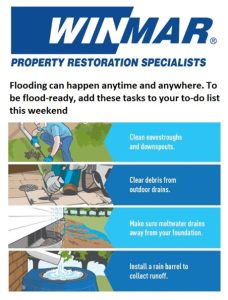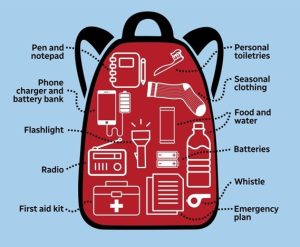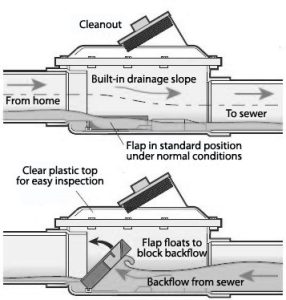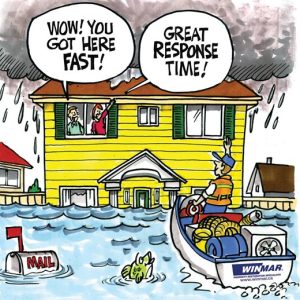Preparing for Flood Season
Preparing for Flood Season
Every spring when the days warm and the ground thaws, WINMAR® Kootenay begins responding to calls of flooded basements, foundation crack repairs, and overland flooding mitigation.
During this seasonal transition to warmer weather, bodies of water begin to reach capacity and the groundwater table becomes saturated. Add into the mix your typical spring rainstorm with nowhere for the water to go, and suddenly you find your home or business falling victim to a flood.
The impacts of floods can be devastating. Sentimental items may be water damaged beyond repair, and depending on the source of water (overland flooding, sewage backup, seepage, etc.), many policies may not provide coverage leaving you responsible for costly repairs.
Flooded basement repairs can cost upwards of $75,000 and take several weeks or months to repair, causing significant disruption to you and your family or your business. Compounded by supply chain disruptions, key building materials such as millwork or flooring may take 4-6 months to arrive.
Effective crisis management plans contain two critical elements:
1) Awareness of the risk, and
2) Preparation.
Now that we understand what the risks are, let’s discuss how floods can be prevented.
Prevention
Elevate
There are certain items and critical utilities you should elevate, including: appliances, heating systems, electrical panels, valuable personal items, and important documents. Remove these items from your basement if possible and ensure that items left in your basement are moved away from windows, as during an overland flooding event, this is where water will enter.
Test your sump pump and install battery backup
Sadly, WINMAR® Kootenay responds to many claims where the home had a sump pump installed, only for it to fail to turn on during a flooding event. Sump pumps should be checked once a year at a minimum for effective operation. Simply open the cover and manually lift your float to ensure it turns on. Do this with water in the sump to ensure the pump seals remain lubricated, but also to test the outfall pipe for leaks. We had one claim where the sump pump was recirculating water back into the home because the outfall pipe was broken. Lastly, ensure you have a battery backup installed on your sump pump because power outages are common during major storms, and you may not always be home to plug your sump pump into a generator.
Clear debris from around your home and look for positive drainage
Remove anything that may cause water to run towards your home, such as: scrap pieces of lumber, garden tractors, and even snowbanks. Often in the spring months we are left with large snowbanks from roof shoveling, which can act like a dam to keep water runoff around the perimeter of your home. Take a step back and look at the grade of your property. Does it slope away from your home or towards it? In the Kootenay region, many older homes that are 50-100 years old undergo localized settlement, causing a small “crater” to form around the perimeter of the home. If left unrepaired, this facilitates water to pool alongside the foundation wall, and ultimately work its way in through either the wall to footing interface, the wall to slab interface, or existing micro cracks in the concrete itself. If you don’t have the room to extend downspouts away from your home, install a rain barrel to collect water; it is also great for keeping your garden healthy and reducing your water bill.
Clean out your gutters
Once the snow has melted off your roof, that is the signal you should clean your gutters. Go up on a ladder and visually inspect them for structural integrity, holes, gaps, wind damage, and ensure there is no debris which could restrict their flow. If you are not comfortable cleaning your gutters, contact us and we can do this for you. Check your downspouts and the outfall locations to ensure water is being shed away from your home and not towards it. Place splash pads below your downspouts to minimize erosion of the soil, and push water away from your home.
Look, listen, and feel
During a major storm event, keep a watchful eye on the high-risk areas of your home in your basement:
- Window wells
- Floor drains
- Shower drains / toilets
- Exterior walls
- Flooring where it touches the perimeter of the home
Look – Look for visual cues of water damage. Does it look wet?
Listen – Sometimes you can hear water trickling. This is the precursor of a major problem about to happen.
Feel – Press your hand down on your carpet. Does it feel wet? Walk on it with your socks, do they absorb any water? Wet building materials will feel colder than dry areas due to the effects of evaporative cooling (this is the same effect as when you step out of the shower and feel cold).
Pack an emergency bag
Secure your family’s phone charger, emergency blanket, first aid kit, identification you usually don’t use (passport, birth certificate), and other important items in large Ziplock or plastic bags, and pack them all together. If you need to leave your home for whatever reason, you’ll be thankful to have this stuff ready to go!
Check your backflow preventer
Backflow preventers are installed in your home’s sanitary line and act like a check valve to ensure if the exterior sewage system is backed up, plugged, or at capacity, that wastewater will not flow back into your home. Open the cover and inspect the valve for its ability to fully seal. Clean this with a toilet brush. Caution: Sewage water contains many pathogens, viruses, and bacteria. Ensure you wear eye protection and avoid getting the water in your mouth or on your skin. If you are not comfortable doing this, call WINMAR® Kootenay and our trained technicians can clean this for you. If you do not have a backflow preventer installed, contact WINMAR® Kootenay for a quote. We will also help you find out if your insurance policy will provide funding towards the preventer, or a discount on your premiums if one is installed.
Know where your electrical disconnect or main panel is
The last thing you want to do is wade through a flooded basement to turn off power to your home that is located on the opposite end of your house. Take a moment before you find yourself in a stressful situation to familiarize yourself with your electrical shutoffs. Some homes are now equipped with an exterior disconnect which can safely cut power form your home without having to enter the structure. Turning power off before a flood reaches electrical outlets not only helps keep first responders safe, but it also helps prevent fires, shorts, and further damage to your home.
Conclusion
As devastating as floods can be, through good planning and routine maintenance you can significantly reduce your exposure to this risk.
A final tip we have is to locate your insurance policy either in your paper files or email. Ensure this is readily available in case you need to review it or consider filing a claim. Policyholders should be cautioned that many insurance carriers will flag your file if you call in inquiring if coverage would apply, and sometimes this simple phone call can affect your future premiums or ability to renew your policy. Take a moment to read through your policy to determine what perils you are covered for, and what your policy limits are. The best time to revise your policy is before you have suffered a loss, not after!
If you are considering filing a claim for water damage, contact WINMAR® Kootenay and we will dispatch a qualified restoration professional to visit your home, assess your damages, and provide detailed information directly to you that will help you decide if contacting your carrier’s claims department will be in your best interests. If you do wish to proceed with the claim, our team of professionals has the very best training and modern equipment to restore your flooded basement safely and efficiently.







